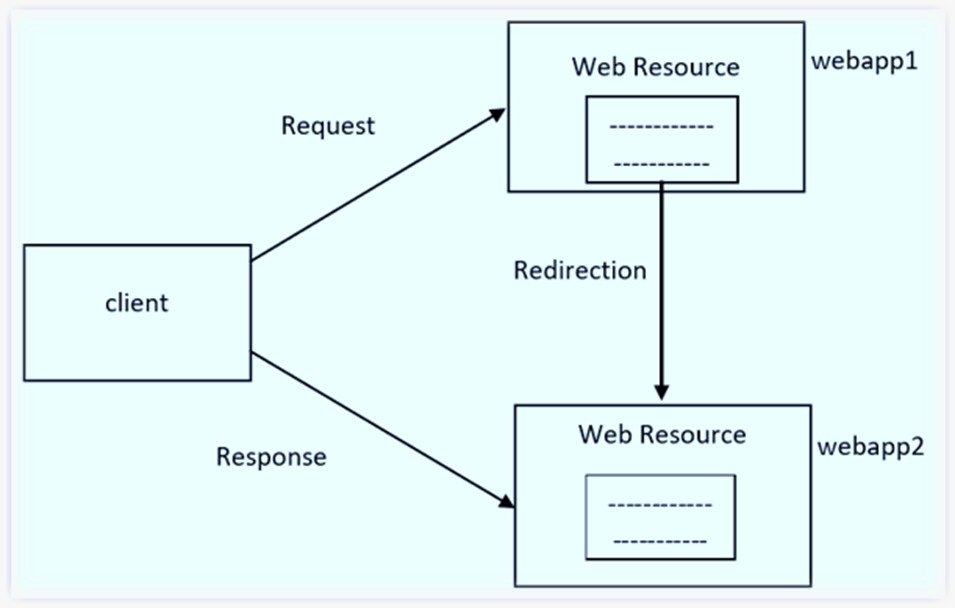Lets try to create one html page and retrieve data to a servlet and add those data and send this data to another servlet to print.
Using sendRedirect involves a slightly different approach. Instead of forwarding the request along with the attributes, the first servlet will send a redirect response to the client, including the result as a query parameter. The second servlet will then read this parameter from the URL.
Step 1: Create the HTML Form
Create an HTML file named input.html.
<!DOCTYPE html>
<html>
<head>
<title>Number Addition</title>
</head>
<body>
<h2>Add Two Numbers</h2>
<form action="add" method="post">
<label for="number1">Number 1:</label>
<input type="text" id="number1" name="number1"><br><br>
<label for="number2">Number 2:</label>
<input type="text" id="number2" name="number2"><br><br>
<input type="submit" value="Submit">
</form>
</body>
</html>
Step 2: Create the First Servlet (AddServlet)
Create a new Java class named AddServlet.java. This servlet will retrieve the numbers from the form, add them, and then send a redirect to the second servlet with the sum included as a query parameter.
import java.io.IOException;
import javax.servlet.ServletException;
import javax.servlet.annotation.WebServlet;
import javax.servlet.http.HttpServlet;
import javax.servlet.http.HttpServletRequest;
import javax.servlet.http.HttpServletResponse;
@WebServlet("/add")
public class AddServlet extends HttpServlet {
private static final long serialVersionUID = 1L;
protected void doPost(HttpServletRequest request, HttpServletResponse response) throws ServletException, IOException {
// Retrieve data from the form
int number1 = Integer.parseInt(request.getParameter("number1"));
int number2 = Integer.parseInt(request.getParameter("number2"));
// Calculate the sum
int sum = number1 + number2;
// Redirect to the ResultServlet with the sum as a query parameter
response.sendRedirect("result?sum=" + sum);
}
}
Step 3: Create the Second Servlet (ResultServlet)
Create a new Java class named ResultServlet.java. This servlet will read the sum from the query parameter and display it.
import java.io.IOException;
import javax.servlet.ServletException;
import javax.servlet.annotation.WebServlet;
import javax.servlet.http.HttpServlet;
import javax.servlet.http.HttpServletRequest;
import javax.servlet.http.HttpServletResponse;
@WebServlet("/result")
public class ResultServlet extends HttpServlet {
private static final long serialVersionUID = 1L;
protected void doGet(HttpServletRequest request, HttpServletResponse response) throws ServletException, IOException {
// Retrieve the sum from the query parameter
int sum = Integer.parseInt(request.getParameter("sum"));
// Display the result
response.setContentType("text/html");
response.getWriter().println("<h1>Result</h1>");
response.getWriter().println("<p>The sum is: " + sum + "</p>");
}
}
Explanation
- HTML Form (
input.html):- Collects two numbers from the user and submits the form data to the
/addURL using a POST request.
- Collects two numbers from the user and submits the form data to the
- AddServlet (
AddServlet.java):- Mapped to
/add. - Retrieves the two numbers from the form, calculates their sum, and then redirects the client to the
/resultURL with the sum included as a query parameter.
- Mapped to
- ResultServlet (
ResultServlet.java):- Mapped to
/result. - Reads the sum from the query parameter and displays it.
- Mapped to
Step 4: Deploy Your Application
- Place
input.htmlin the web directory (e.g.,webapps/your_project_nameif using Tomcat). - Compile and deploy
AddServlet.javaandResultServlet.javaas part of your web application. - Start your server (Tomcat) and navigate to
http://localhost:8080/your_project_name/input.htmlin your web browser.
When you fill out the form and click “Submit,” the AddServlet will handle the request, add the numbers, and send a redirect to the ResultServlet with the sum included in the URL. The ResultServlet will then display the sum.



